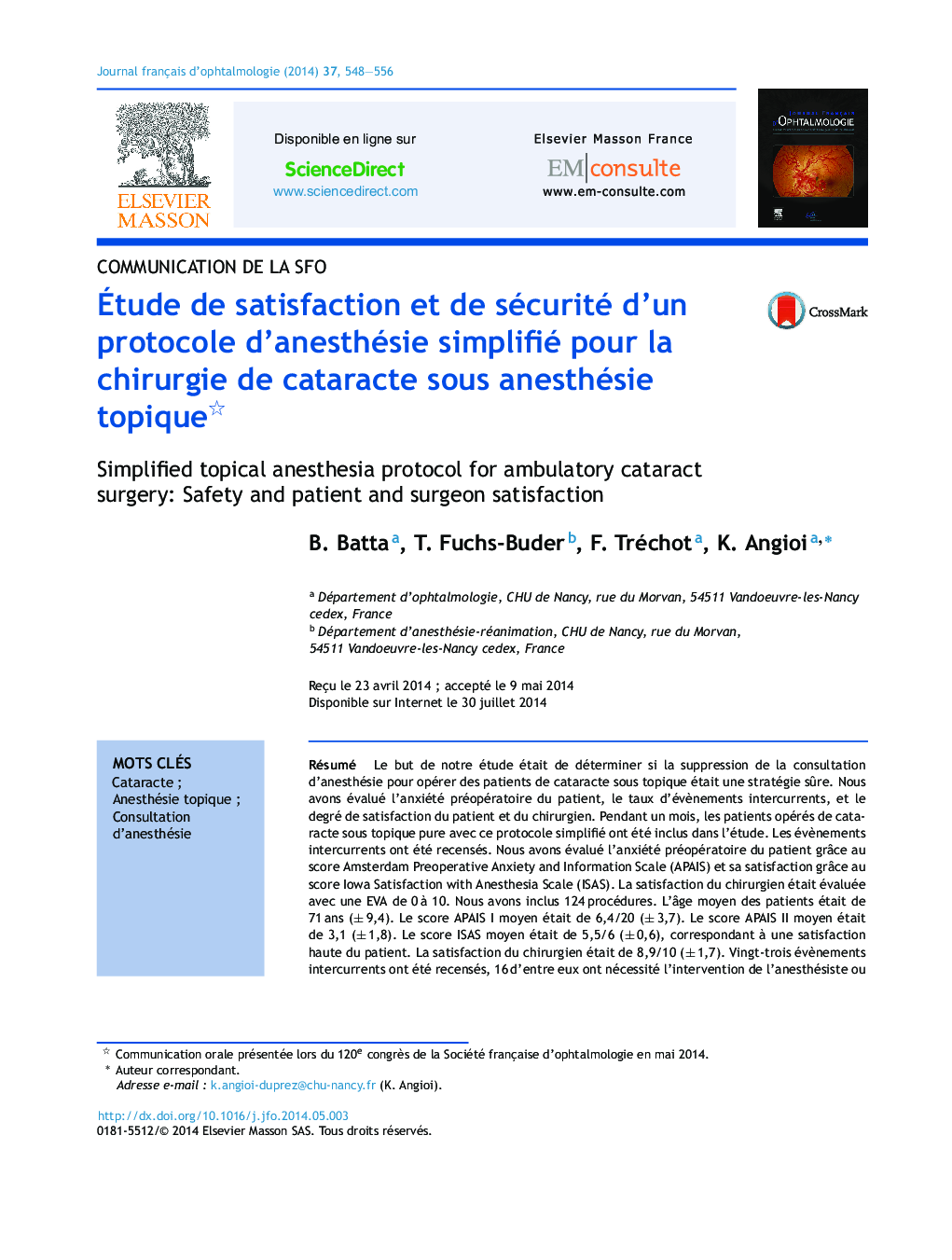| Article ID | Journal | Published Year | Pages | File Type |
|---|---|---|---|---|
| 4023540 | Journal Français d'Ophtalmologie | 2014 | 9 Pages |
RésuméLe but de notre étude était de déterminer si la suppression de la consultation d’anesthésie pour opérer des patients de cataracte sous topique était une stratégie sûre. Nous avons évalué l’anxiété préopératoire du patient, le taux d’évènements intercurrents, et le degré de satisfaction du patient et du chirurgien. Pendant un mois, les patients opérés de cataracte sous topique pure avec ce protocole simplifié ont été inclus dans l’étude. Les évènements intercurrents ont été recensés. Nous avons évalué l’anxiété préopératoire du patient grâce au score Amsterdam Preoperative Anxiety and Information Scale (APAIS) et sa satisfaction grâce au score Iowa Satisfaction with Anesthesia Scale (ISAS). La satisfaction du chirurgien était évaluée avec une EVA de 0 à 10. Nous avons inclus 124 procédures. L’âge moyen des patients était de 71 ans (± 9,4). Le score APAIS I moyen était de 6,4/20 (± 3,7). Le score APAIS II moyen était de 3,1 (± 1,8). Le score ISAS moyen était de 5,5/6 (± 0,6), correspondant à une satisfaction haute du patient. La satisfaction du chirurgien était de 8,9/10 (± 1,7). Vingt-trois évènements intercurrents ont été recensés, 16 d’entre eux ont nécessité l’intervention de l’anesthésiste ou du chirurgien : 5 compléments d’anesthésie locale ou locorégionale, 6 compléments d’analgésie IV, 5 cas d’hypertension traités. Le protocole simplifié est une stratégie sûre, satisfaisante pour le patient et pour le chirurgien dans la mesure où l’équipe anesthésique est disponible dans le bloc opératoire.
SummaryBackground and purpose of studyThe purpose of our study was to assess safety and efficacy of cataract surgery (CS) under topical anesthesia alone, i.e. without pre-anesthetic evaluation and without direct presence of an anesthesiologist. To this end we assessed the incidence of patients’ preoperative anxiety, perioperative adverse events and patients’ and surgeons’ satisfaction.Materials and methodsPatients undergoing CS under topical anesthesia over a one-month period were included. An anesthesiologist and nurse anesthetist were present in the area and could intervene in case of an adverse event. Patients’ anxiety was scored using the Amsterdam Preoperative Anxiety & Information Scale (APAIS), and their satisfaction with the Iowa Satisfaction with Anesthesia Scale (ISAS). Surgeons’ satisfaction was scored with a VAS from 0 to 10 (0: surgery not possible & 10: excellent surgical conditions).Results and discussionOne hundred and twenty-four consecutive patients were included; mean age was 71 (± 9.4) years. Mean APAIS I was 6.4/20 (± 3.7). Mean APAIS II was 3.1 (± 1.8). Mean ISAS score was 5.5/6 (± 0.6), indicating high patient satisfaction. Surgeon satisfaction score was 8.9/10 (± 1.7). Twenty-three adverse events occurred of which 16 required interventions by the anaesthesiologist or surgeon: 5 supplemental local or regional anaesthesia, 6 iv-analgesia, 5 management of hypertension.ConclusionThese preliminary data suggest that a simplified topical anesthesia protocol for ambulatory CS appears to be feasible and safe, as long as an anesthesia team is present in the area to intervene if needed.
